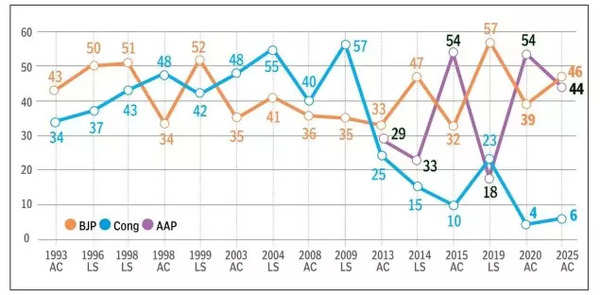NEW DELHI: BJP scored a spectacular victory in all parliamentary constituency areas to win 48 of the 70 assembly seats in the capital. In particular, it was the party’s performance in outer Delhi, areas bordering Haryana, that helped it rout AAP and storm back to power after 27 years. AAP, for its part, continued its impressive run in Muslim- and Dalit-dominated seats apart from winning isolated pockets with a higher number of JJ clusters and unauthorised colonies.
BJP triumphed in nine of the 10 seats in the West Delhi parliamentary constituency, eight each in North West Delhi and East Delhi and seven in New Delhi.
Delhi Election Results 2025
The remaining seats came from Chandni Chowk, where six of its candidates emerged victorious, and five each in South Delhi and North East Delhi.
In the 2020 assembly polls, when BJP tallied just eight seats, the party had failed to win a single seat in New Delhi, West Delhi, South Delhi and Chandni Chowk. While one BJP candidate was elected from North West Delhi, three each returned from East Delhi and North East Delhi.
BJP, thus, not only made inroads in urban pockets of central Delhi and New Delhi this time, but also almost swept the outer Delhi areas and rural parts of the city. “Of the 13 seats that share a border with Uttar Pradesh, we got seven while of the 11 constituencies on the border with Haryana, we won nine,” smiled a BJP functionary.

Narela, Mundka, Badli, Najafgarh, Palam, Bijwasan, Matiala, Chhatarpur and Mehrauli were some of the prominent rural seats where BJP had failed to do anything impressive in the last two elections but where it performed extremely well this year. Surender Solanki, chief of Palam 360 Khap, said the rural voters came out in large numbers to support BJP. “The villages, be it rural or urban, were completely ignored by Delhi govt. We ran a campaign, visited every single city village, interacted with the residents and prepared a list of demands. We approached all political parties. While AAP continued to ignore us, the PM called us as did the Union home minister and assured us our issues will be addressed. The Khap, accordingly, supported BJP,” said Solanki.
The Khap chief added that BJP managed to wrest several seats with the support of the villagers from AAP, which itself had grabbed them from Congress in 2013.
AAP held on to its support base in reserved constituencies. While the party had won all 12 SC seats in 2015 and 2020, it retained eight seats this time. Similarly, people came out in large numbers in constituencies dotted with unauthorised colonies in its support. Gokalpur, Ambedkar Nagar, Kondli, Okhla, Badarpur, Tughlaqabad, Deoli, Kirari, Burari and Sultanpur Majra are known for having large clusters of unauthorised colonies.
An AAP functionary explained why. “In our campaign, we highlighted the work done by our govt to improve the amenities in the city’s 1,797 unauthorised colonies. We connected these colonies with sewer and water pipelines, laid down roads, built drains and improved overall living conditions. The support we got from the residents of some of such colonies is a validation of our work.”
While the Muslim vote showed signs of division in a couple of constituencies, it largely went in the favour of AAP, getting big victories for its candidates. Except Mustafabad, where the Hindu votes consolidated against a trifurcation of Muslims votes, AAP won comprehensively in Okhla, Seelampur, Matia Mahal and Ballimaran. It also performed reasonably well in areas where Muslims live in large numbers but are not the deciding force, such as at Kirari and Seemapuri.
Despite being the partners in the INDIA bloc, a grouping of opposition parties at the national level, AAP and Congress contested the assembly election separately. This was to BJP’s advantage. According to an analysis, there are 14 seats that BJP won because Congress garnered more votes than the margin between the winner and the closest rival. These seats are Timarpur, Badli, Nangloi Jat, Madipur, Rajendra Nagar, New Delhi, Jangpura, Kasturba Nagar, Malviya Nagar, Mehrauli, Chhatarpur, Sangam Vihar, Greater Kailash and Trilokpuri.
Some political observers believed that had Congress and AAP contested the election as alliance partners, the results could have been different. Although the vote cutting by Congress was evident in its candidates saving their security deposits only in Kasturba Nagar, Badli and Nangloi Jat, a Congress functionary refused to accept the theory. “We contested the Lok Sabha election jointly and the result was we failed to win a single seat. Theoretically, one can say that the alliance could have prevented the BJP juggernaut, but the results could have been totally different too,” the Congress member argued.
